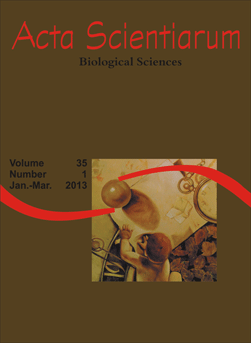<b>Biochemical changes in <i>Salminus brasiliensis</i> due to successive captures and stocking densities</b> - doi: 10.4025/actascibiolsci.v35i1.13055
Resumo
This study evaluated the biochemical changes associated to successive captures of Salminus brasiliensis reared at different stocking densities. The experiment was conducted in tanks with a capacity of
1,000 L, connected to a recirculating system with temperature control and continuous aeration. Fish were stocked at densities of 30, 150 and 300 fish m-3 and the successive catches were applied at the end of the experimental period of 80 days. The biochemical changes were evaluated at the end of the trial through the parameters: hematocrit, hemoglobin, glucose and lactate in plasma and Na+, K+ and Cl- and Ca2+ in the gills. The concentration of glucose increased with the increase of stocking density as also registered for lactate concentration, except for fish captured twice. Hemoglobin concentration increased with the increase of stocking density only in fish captured three times. The hematocrit and the ions in the gills had no variation under any condition and therefore, the ionic alterations characteristic of a stress response, were not found in this species. The successive captures associated to stocking density were related to biochemical changes in S. brasiliensis, but ion concentrations in gills were not indicators of this condition.
Downloads
DECLARAÇÃO DE ORIGINALIDADE E DIREITOS AUTORAIS
Declaro que o presente artigo é original, não tendo sido submetido à publicação em qualquer outro periódico nacional ou internacional, quer seja em parte ou em sua totalidade.
Os direitos autorais pertencem exclusivamente aos autores. Os direitos de licenciamento utilizados pelo periódico é a licença Creative Commons Attribution 4.0 (CC BY 4.0): são permitidos o compartilhamento (cópia e distribuição do material em qualqer meio ou formato) e adaptação (remix, transformação e criação de material a partir do conteúdo assim licenciado para quaisquer fins, inclusive comerciais.
Recomenda-se a leitura desse link para maiores informações sobre o tema: fornecimento de créditos e referências de forma correta, entre outros detalhes cruciais para uso adequado do material licenciado.












1.png)




3.png)













